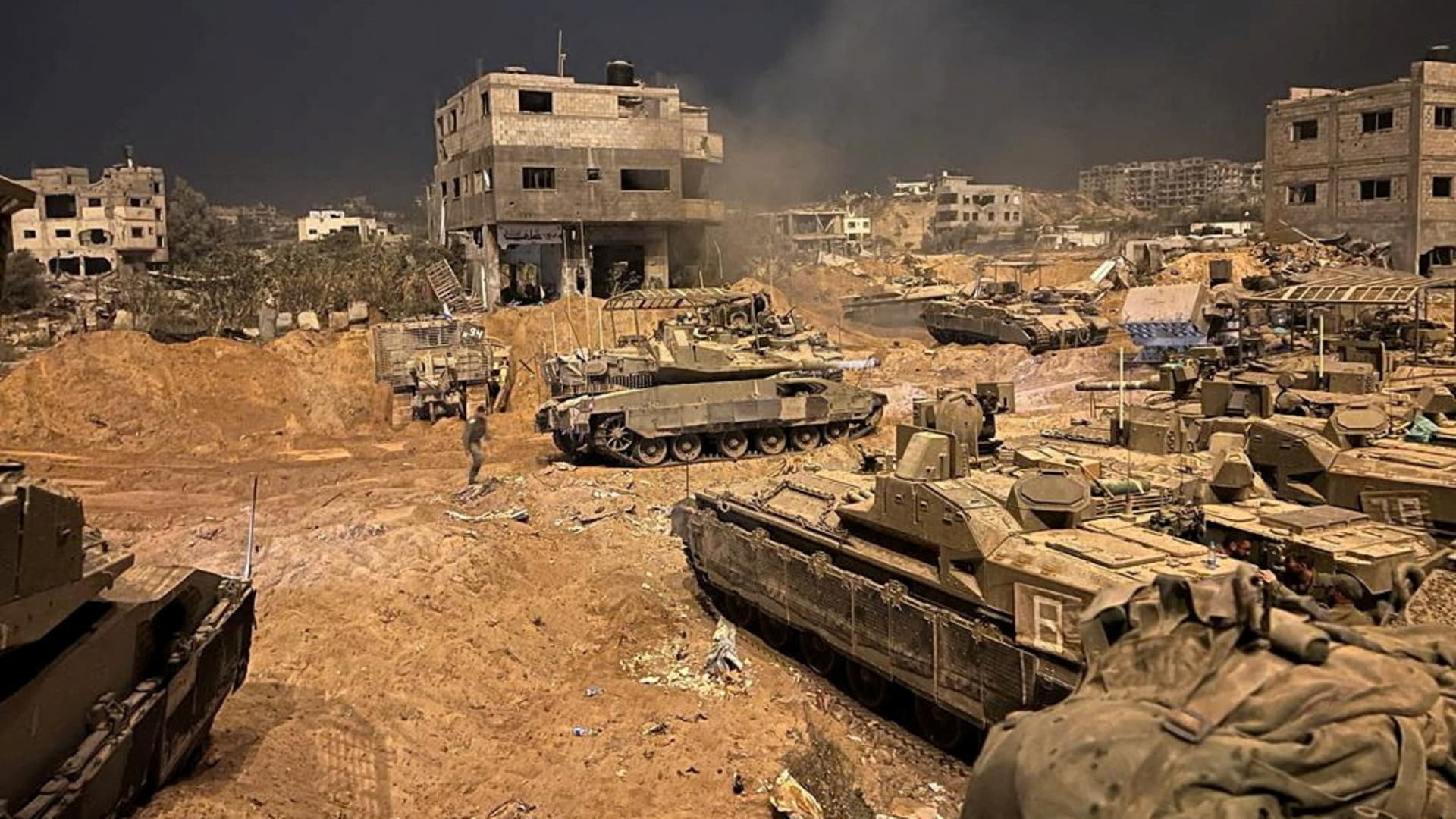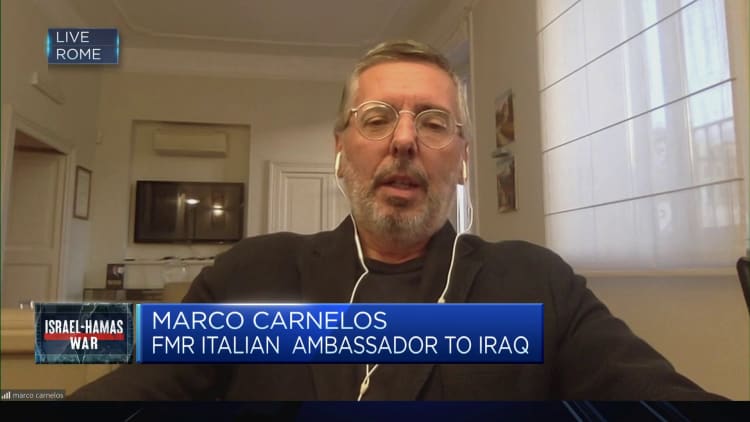
 business
business 
Armoured vehicles of the Israel Defense Forces (IDF) are seen during their ground operations at a location given as Gaza, as the conflict between Israel and the Palestinian Islamist group Hamas continues, in this handout image released on November 1, 2023.
Israel Defense Forces | Reuters
Israeli Prime Minister Benjamin Netanyahu warned his country that a “long and difficult war” lay ahead.
The Israeli Defense Forces, after launching the largest military mobilization of troops in its history, has now entered into the “second phase” of its war against Hamas in the Gaza Strip. The IDF is supplementing heavy aerial bombardment of the besieged territory with what’s been described as a ground incursion, the details of which have been kept closely guarded.
The airstrikes began in response to the Oct. 7 attack by Palestinian militant organization Hamas – designated a terrorist group by the U.S. and EU – on southern Israel that killed more than 1,300 people and saw more than 240 taken hostage. And the IDF’s long-held strategy of retaliation is in full force, with more than 8,500 people killed in Gaza in just over three weeks, according to Hamas-run health ministry authorities there.
In the first six days of the war alone, Israel’s military said it dropped 6,000 bombs on Gaza – a blockaded enclave roughly the size of the city of Philadelphia. Now, ground troops are moving into the territory.
Civilians try to reach survivors, dead bodies amid destruction caused by Israeli strikes on Bureij refugee camp located in central Gaza Strip on November 02, 2023.
Ashraf Amra | Anadolu Agency | Getty Images
“Our soldiers have been operating in Gaza City for the past few days, surrounding it from several directions, deepening the operation,” the IDF’s Chief of Staff Lt. Gen. Herzi Halevi said Thursday. “Our forces are in very significant areas of Gaza City.”
A ground offensive is necessary to achieve Israel’s goal of eliminating Hamas, which controls the Gaza Strip, the IDF says. A prolonged invasion, however — should it become that — will be bloody and costly not only for those living in Gaza but for the Israeli military as well, military veterans and analysts say.
Urban counter-insurgency, as the U.S. military learned in Iraq, brings deadly challenges to troops that do not apply in an aerial campaign.
“In urban combat, you take higher casualties. That’s just a historical fact,” Jim Webb, a former U.S. Marine infantryman who served in Iraq and Afghanistan, told CNBC.
“Iraq showed just how much of an advantage the defender, particularly an asymmetrical one, has in urban combat. There, lightly armed insurgents were able to use the urban landscape to first slow and then tie down the greatest maneuver force in world history for years.”
In the case of Gaza, that defender is Hamas — and it will have almost every advantage in ground fighting, Webb said.
“Cities naturally canalize the attacker into predictable avenues of approach. It also means these fights happen at close range, which makes the use of supporting arms, such as tanks, artillery, or air power, extremely difficult, even if there are no civilians in the area,” Webb said.
“Gaza is full of civilians, and Hamas will be able to blend in,” he added. “I do not envy the task the IDF may be asked to undertake.”
Palestinian members of the al-Qassam Brigades, the armed wing of the Hamas movement, take part in a gathering on Jan. 31, 2016, in Gaza City to pay tribute to their fellow militants who died after a tunnel collapsed in the Gaza Strip.
Mahmud Hams | Afp | Getty Images
Israeli soldiers will be dealing with unfamiliar streets and alleyways, mountains of demolished buildings, and Hamas’ extensive tunnel network, which the IDF euphemistically calls the “Gaza metro.” Hundreds of feet underground, the tunnels house weapons stocks, electrical generators, command and control centers undetectable from above — and likely many of the hostages that Hamas kidnapped from Israel on Oct. 7.
“We know they’re waiting for us,” one Israeli soldier, who declined to be named due to his role in Israel’s security service, told CNBC. “And as bad as Gaza is above ground, underground is much worse.”
No one knows how long the militants will last, says Hussein Ibish, a senior resident scholar at the Arab Gulf States Institute in Washington. But he suspects that drawing Israel into a prolonged ground invasion is actually Hamas’ goal.
“I think their plan is to inflict as much cost on Israel as possible during its ground incursion and ensure that pockets of the organization survive so that, assuming that Israel does engage in a long-term ground presence in Gaza urban centers, it can launch an insurgency,” Ibish said.
That insurgency would likely begin slowly because the organization is so decimated, he said, but a high risk remains that it could gain steam over time. “Hamas hopes to be able to eventually start picking off Israeli soldiers individually and in small groups,” he said, “killing and capturing them, and bleeding Israel horrendously.”
The IDF did not immediately respond to a CNBC request for comment.

“In terms of Israel’s stated strategic games, I think that it’s going to be really difficult,” said Dave Des Roches, a professor at the Near East South Asia Center for Strategic Studies at the National Defense University in Washington, D.C.
“It’s just not going to be the ’67 war,” he said, referencing Israel’s Six Day War in 1967 during which it rapidly defeated three neighboring Arab armies and gained territory four times its original size. “No,” Des Roches said, “it’s going to be long and it’s going to be bloody.”
A captain in the IDF, who spoke to CNBC anonymously due to restrictions on speaking to the press, said that Israeli troops were fully aware of the risks and prepared to take them on.
“We are ready to inflict serious damage if we do go in despite the potential military casualties. Absolutely,” he said. “We have trained for this exact situation.”
Des Roches believes that destroying Hamas’s military capability will require the IDF to control the ground, essentially occupy it piece by piece, and then systematically map out and destroy what the militants themselves have described as more than 300 miles of tunnels built over the last 30 years.
But taking out Hamas as a military force may be just the beginning of Israel’s challenges, conflict analysts warn. What of the roughly 2.3 million Palestinians left, still trapped in a destroyed Gaza in what the U.N. has described as a catastrophic humanitarian crisis?
“Once you’ve destroyed Gaza, once you’ve destroyed Hamas – assuming you can do that – you’ve got more than two million destitute people,” Des Roches said. “And if you don’t give them a better way of life, you’re just going to have this problem again in five or ten years.”
24World Media does not take any responsibility of the information you see on this page. The content this page contains is from independent third-party content provider. If you have any concerns regarding the content, please free to write us here: contact@24worldmedia.com